Effect of Solution Temperature on Tension-Compression Asymmetry in Metastable β-Titanium Alloys
Abstract
:1. Introduction
2. Materials and Methods
3. Results and Discussion
3.1. Microstructure
3.2. Hardness Test
3.3. Compressive Mechanical Properties
3.4. Tensile Mechanical Properties
3.5. Asymmetry
3.5.1. Asymmetry of Yield Stress
3.5.2. Asymmetry of Strain Hardening Rate
3.5.3. Asymmetry of Tensile-Compressive Final Strength
3.5.4. The Analysis of Tension-Compression Asymmetry
4. Conclusions
- (1)
- The microstructures of Ti-10V-1Fe-3Al, Ti-10V-2Fe-3Al and Ti-10V-2Cr-3Al alloys changed significantly after 700 °C, 800 °C, 900 °C and 1000 °C, which had an important impact on the hardness of the alloys.
- (2)
- Different solution temperatures have a very significant impact on the compressive and tensile properties of the three alloys. During compression deformation, the samples with solid solution at 800 °C and above produced obvious stress-induced martensitic transformation, while no transformation occurs during tensile deformation.
- (3)
- There are obvious asymmetries in yield strength, strain hardening rate and final strength of the three alloys during compression deformation and tensile deformation.
- (4)
- The difference in the number of twins between uniaxial tension and uniaxial compression, the presence or absence of stress-induced martensitic transformation, and the asymmetry of CRSS of cone <c + a> slip may be the reasons for the asymmetry of mechanical properties of these alloys.
- (5)
- Different elements have a great impact on the deformation mode of the alloys, but the fundamental mechanism is complex and still unclear, so for the further investigation, this needs further research.
Author Contributions
Funding
Institutional Review Board Statement
Informed Consent Statement
Data Availability Statement
Conflicts of Interest
References
- Xiao, H.; Liu, X.Y.; Lu, Q.H.; Hu, T.; Hong, Y.; Li, C.; Zhong, R.J.; Chen, W.L. Promoted low temperature plasma nitriding for improving wear performance of arc-deposited ceramic coatings on Ti6Al4V alloy via shot peening pretreatment. J. Mater. Res. Tecchnol. 2022, 19, 2981–2990. [Google Scholar] [CrossRef]
- Li, C.; Li, H.; Van der Zwaag, S. Unravelling the abrasion resistance of two novel meta-stable titanium alloys on the basis multi-pass-dual-indenter tests. Wear 2019, 440–441, 203094. [Google Scholar] [CrossRef]
- Hanawa, T. Titanium-tissue interface reaction and its control with surface treatment. Front. Bioeng. Biotech. 2019, 7, 170. [Google Scholar] [CrossRef]
- Li, C.; Qin, L.; Li, M.; Xiao, H.; Wang, Q.; Chen, J. Influence of deformation strain rate on the mechanical response in a metastable titanium alloy with various microstructures. J. Alloys Compd. 2020, 815, 152426. [Google Scholar] [CrossRef]
- Manshadi, A.D.; Dippenaar, R.J. Strain-induced phase transformation during thermo-mechanical processing of titanium alloys. Mater. Sci. Eng. A 2012, 552, 451–456. [Google Scholar] [CrossRef]
- Seshacharyulu, T.; Medeiros, S.; Frazier, W.; Prasad, Y. Microstructural mechanisms during hot working of commercial grade Ti-6Al-4V with lamellar starting structure. Mater. Sci. Eng. A 2002, 325, 112–125. [Google Scholar] [CrossRef]
- Clément, N.; Lenain, A.; Jacques, P.J. Mechanical property optimization via microstructural control of new metastable beta titanium alloys. JOM 2007, 59, 50–53. [Google Scholar] [CrossRef]
- Chamanfar, A.; Huang, M.F.; Pasang, T.; Tsukamoto, M.; Misiolek, W.Z. Microstructure and mechanical properties of laser welded Ti-10V-2Fe-3Al (Ti1023) titanium alloy. J. Mater. Sci. Tecchnol. 2020, 9, 7721–7731. [Google Scholar] [CrossRef]
- Chen, Y.; Du, Z.; Xiao, S.; Xu, L.; Tian, J. Effect of aging heat treatment on microstructure and tensile properties of a new β high strength titanium alloy. J. Alloys Compd. 2014, 586, 588–592. [Google Scholar] [CrossRef]
- Srinivasu, G.; Natraj, Y.; Bhattacharjee, A.; Nandy, T.K.; Rao, G.V.S.N. Tensile and fracture toughness of high strength β titanium alloy, Ti-10V-2Fe-3Al, as a function of rolling and solution treatment temperatures. Mater. Design. 2013, 47, 323–330. [Google Scholar] [CrossRef]
- Tuninetti, V.; Gilles, G.; Milis, O. Anisotropy and tension–compression asymmetry modeling of the room temperature plastic response of Ti-6Al-4V. Int. J. Plast. 2015, 67, 53–68. [Google Scholar] [CrossRef]
- Lin, P.; Hao, Y.; Zhang, B.; Zhang, S.; Chi, C.; Shen, J. Tension-compression asymmetry in yielding and strain hardening behavior of CP-Ti at room temperature. Mater. Sci. Eng. A 2017, 707, 172–180. [Google Scholar] [CrossRef]
- Zhang, Q.; Zhang, J.; Wang, Y. Effect of strain rate on the tension–compression asymmetric responses of Ti-6.6 Al-3.3 Mo-1.8 Zr-0.29 Si. Mater. Design. 2014, 61, 281–285. [Google Scholar] [CrossRef]
- Murasawa, G.; Morimoto, T.; Yoneyama, S. Nucleation and growth behavior of twin region around yield point of polycrystalline pure Ti. Exp. Mech. 2012, 52, 503–512. [Google Scholar] [CrossRef]
- Zhang, B.; Wang, J.; Wang, Y.; Li, Z.R. Strain-rate-dependent tensile response of Ti-5Al-2.5 Sn alloy. Materials 2019, 12, 659. [Google Scholar] [CrossRef]
- Li, C.; Huang, C.; Ding, Z.L.; Zhou, X. Research on High-Temperature Compressive Properties of Ti-10V-1Fe-3Al Alloy. Metals 2022, 12, 526. [Google Scholar] [CrossRef]
- Zhang, B.; Wang, J.; Wang, Y.; Li, Z.R.; Wang, Y. Dynamic strain-rate effect on uniaxial tension deformation of Ti5Al2.5Sn titanium alloy at various temperature. Mater. High. Temp. 2019, 36, 479–488. [Google Scholar] [CrossRef]
- Fundenberger, J.J.; Philippe, M.J.; Wagner, F.; Esling, C. Modelling and prediction of mechanical properties for materials with hexagonal symmetry (zinc, titanium and zirconium alloys). Acta Mater. 1997, 45, 4041–4055. [Google Scholar] [CrossRef]
- Lecomte, J.S.; Philippe, M.J.; Klimanek, P. Plastic deformation of a Ti-6%Al-4%V alloy with a strong transverse-type crystallographic a-texture at elevated temperature. Mater. Sci. Eng. A 1997, 234–236, 869–872. [Google Scholar] [CrossRef]

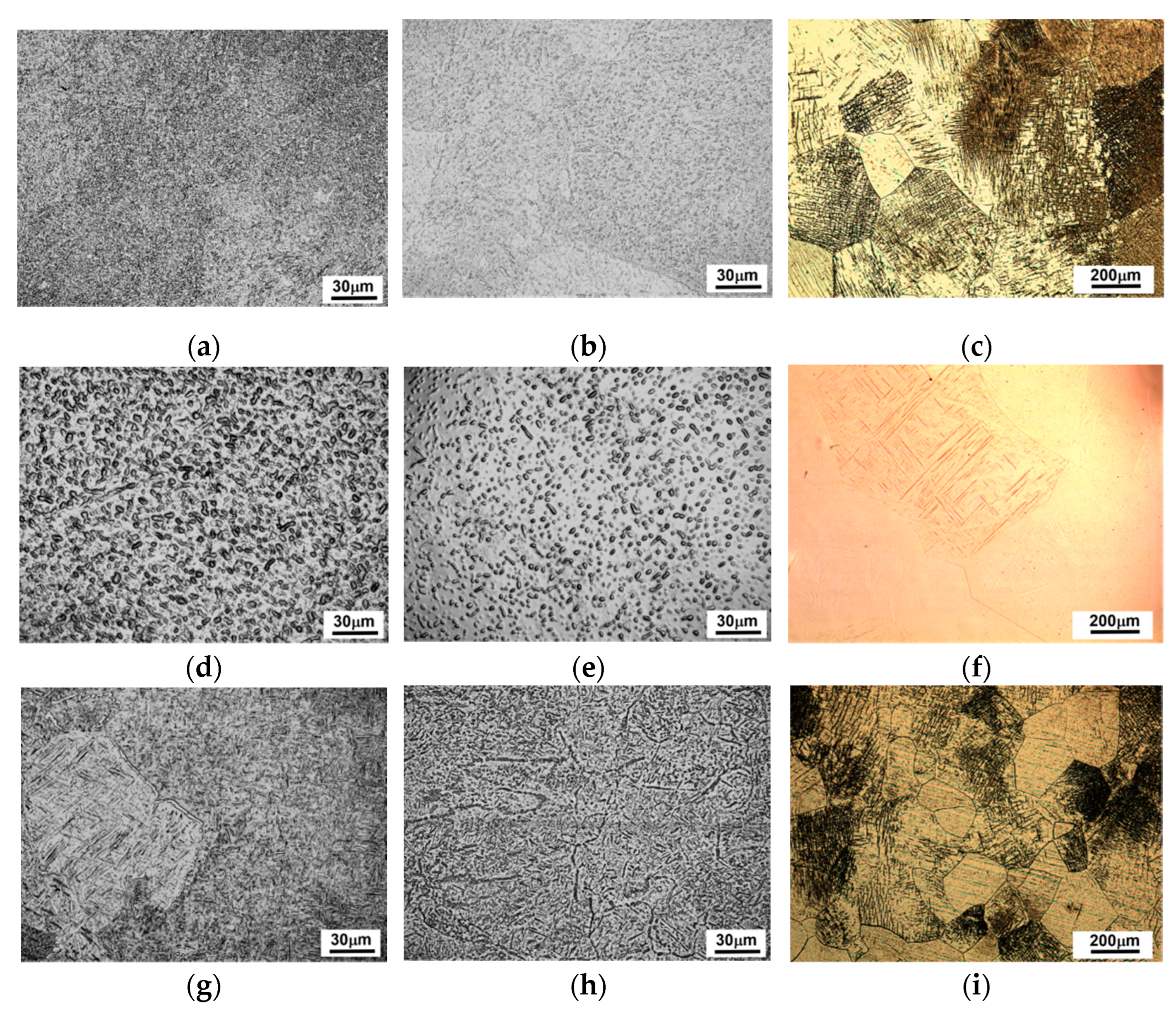


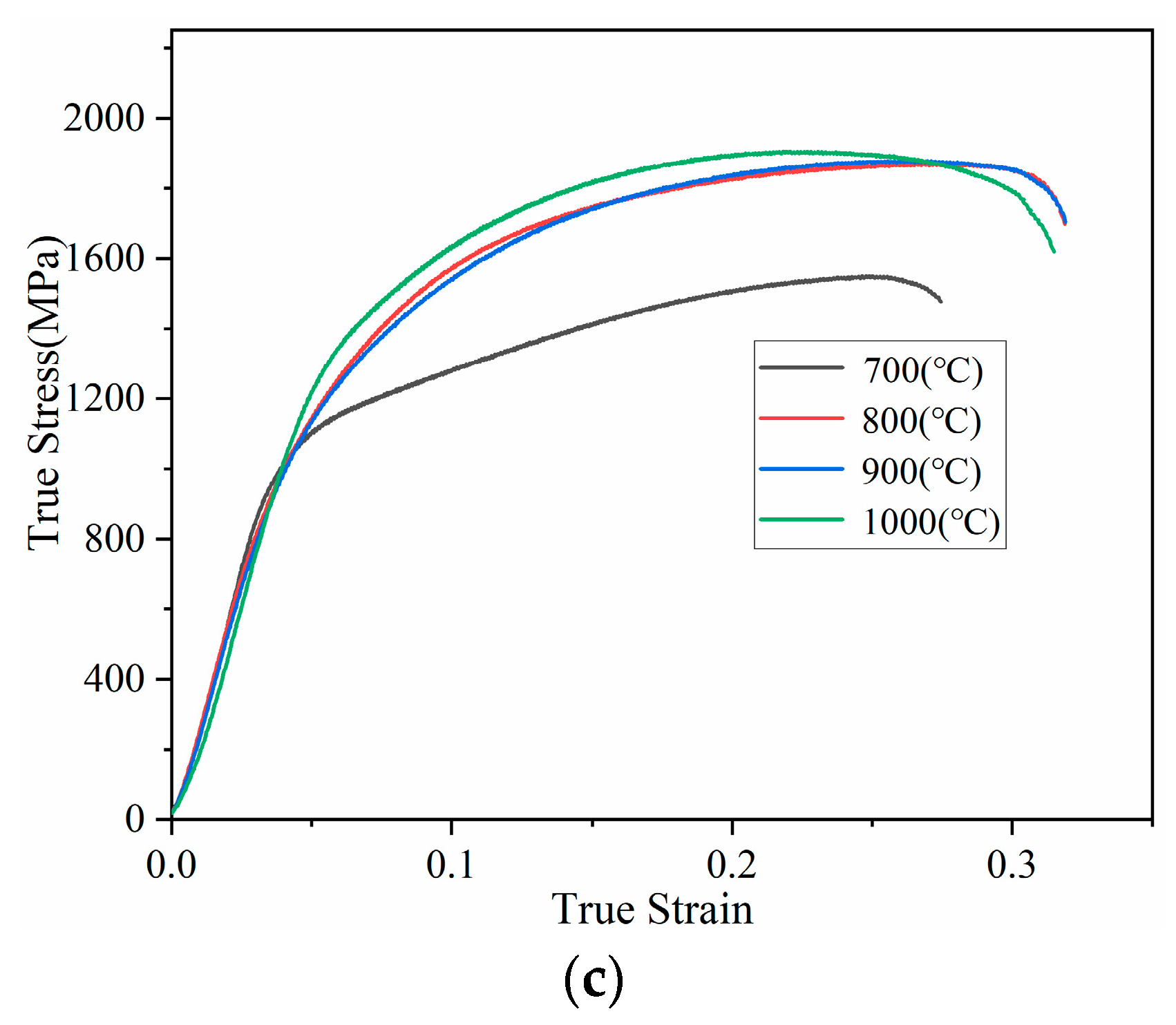

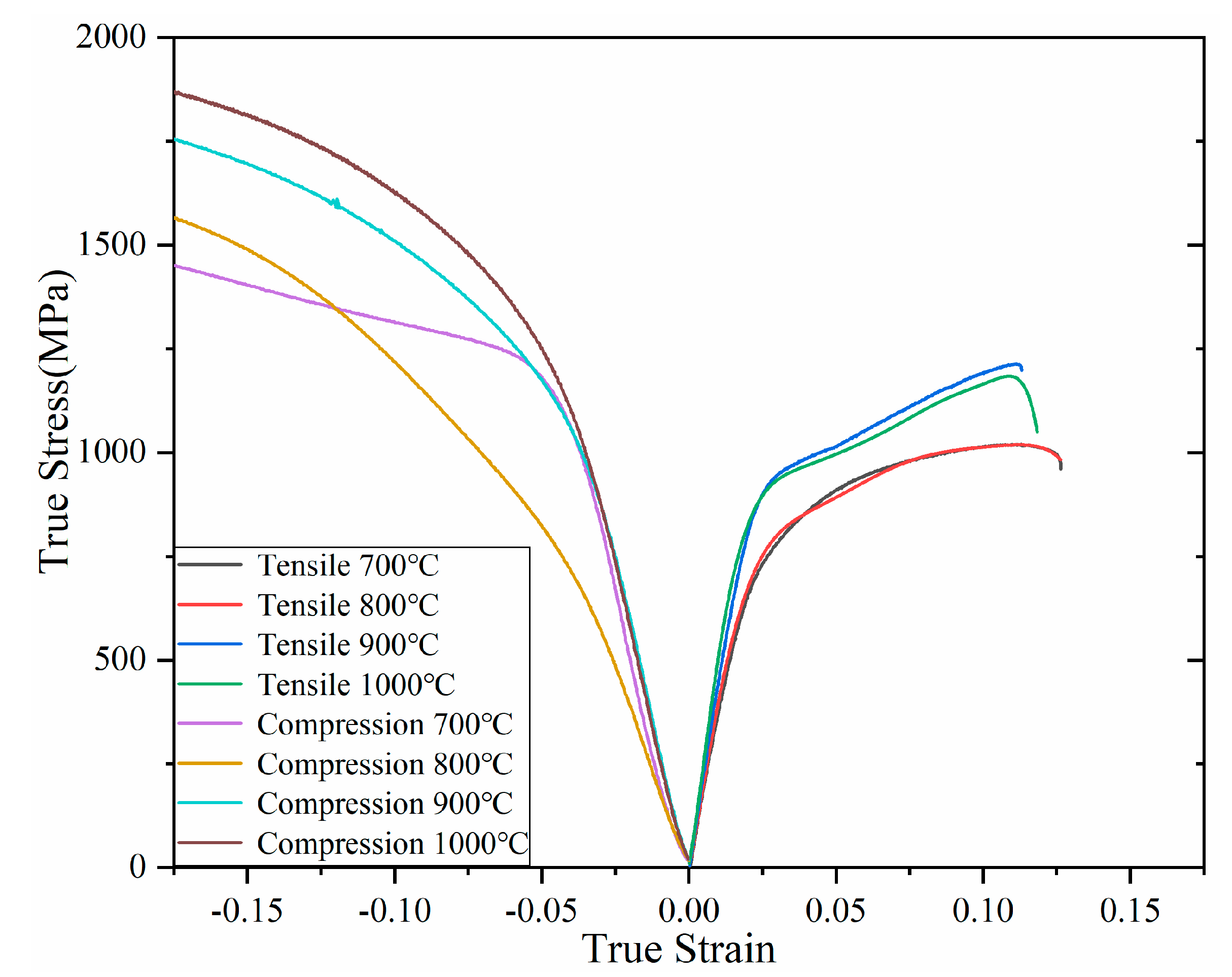
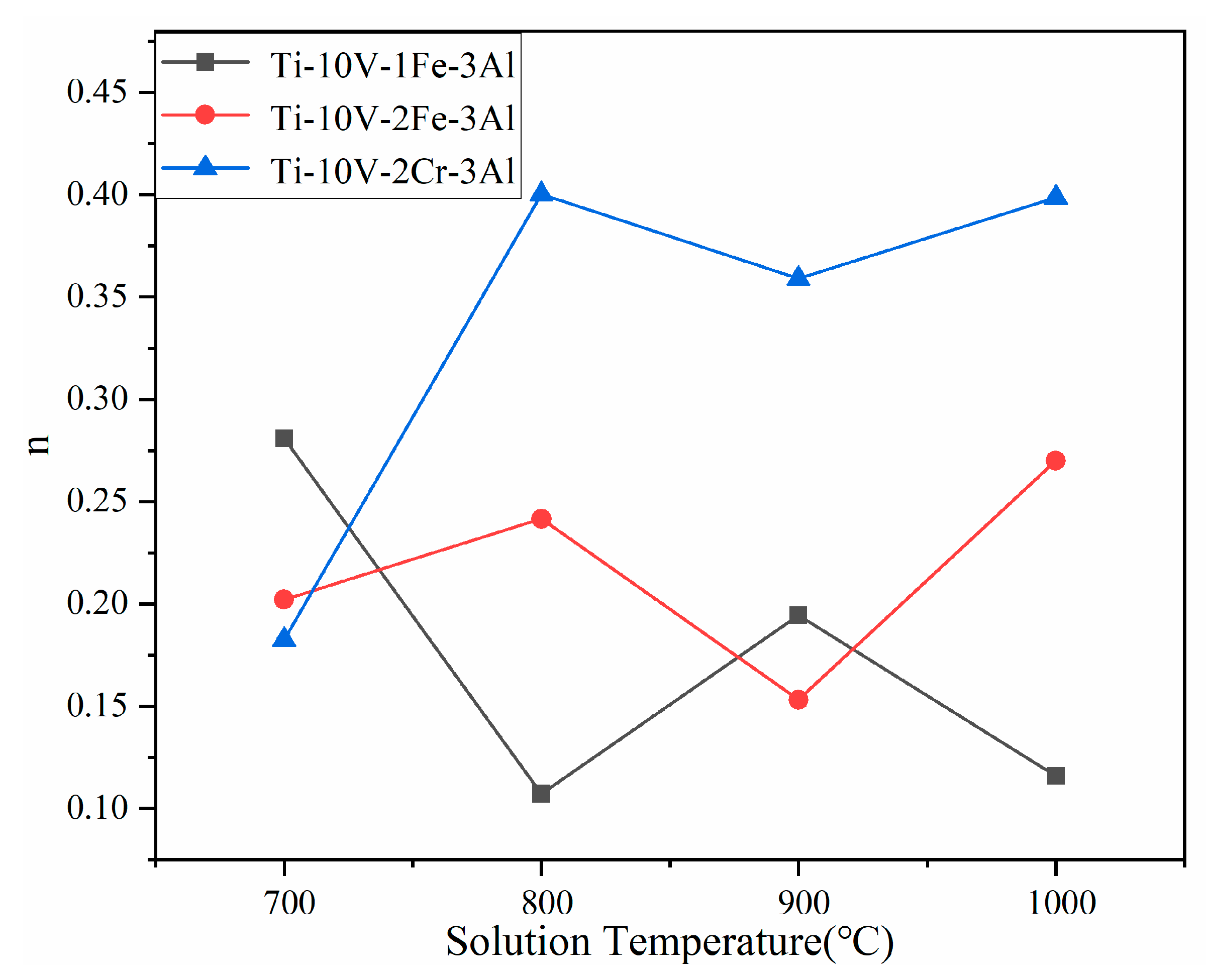

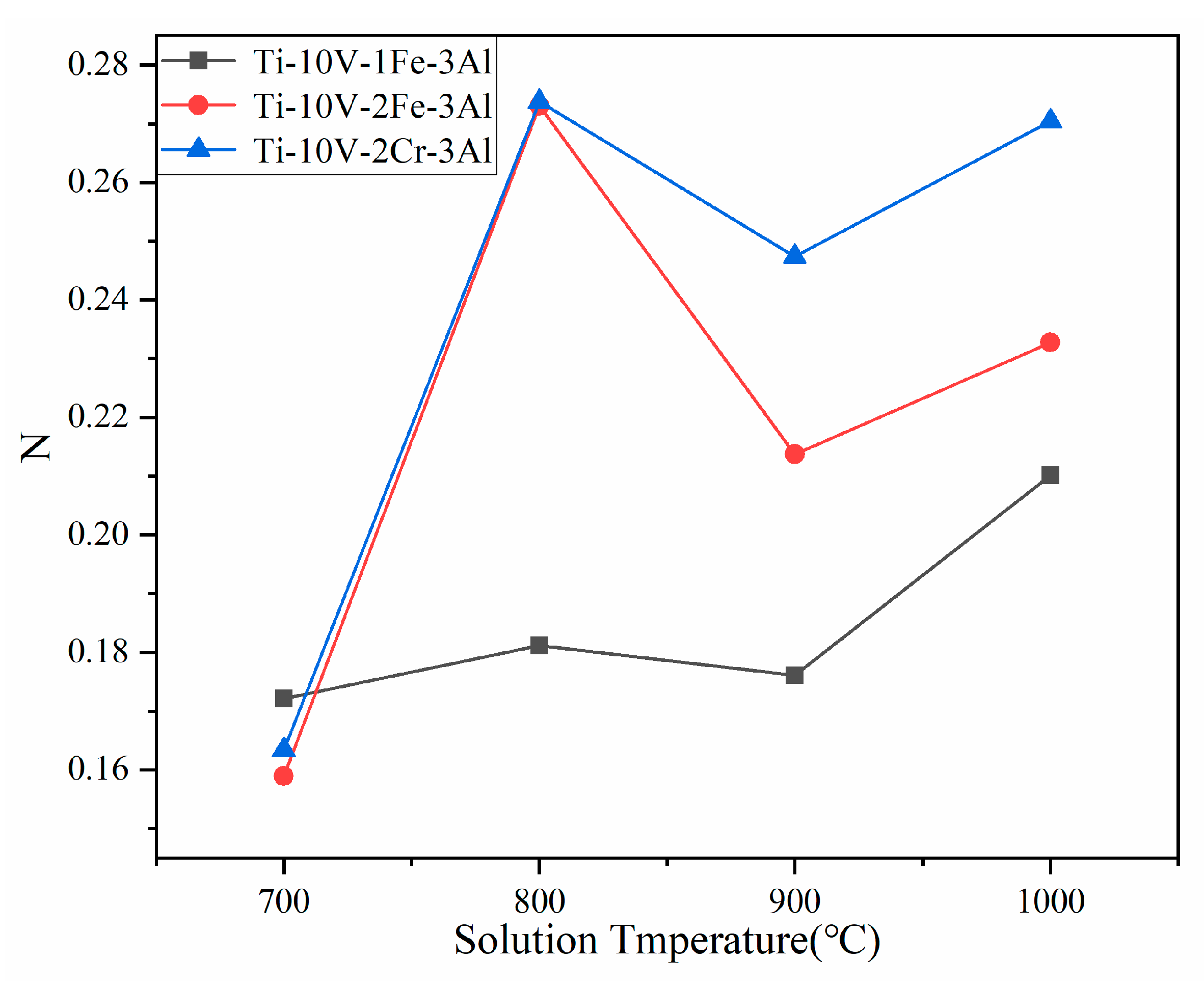
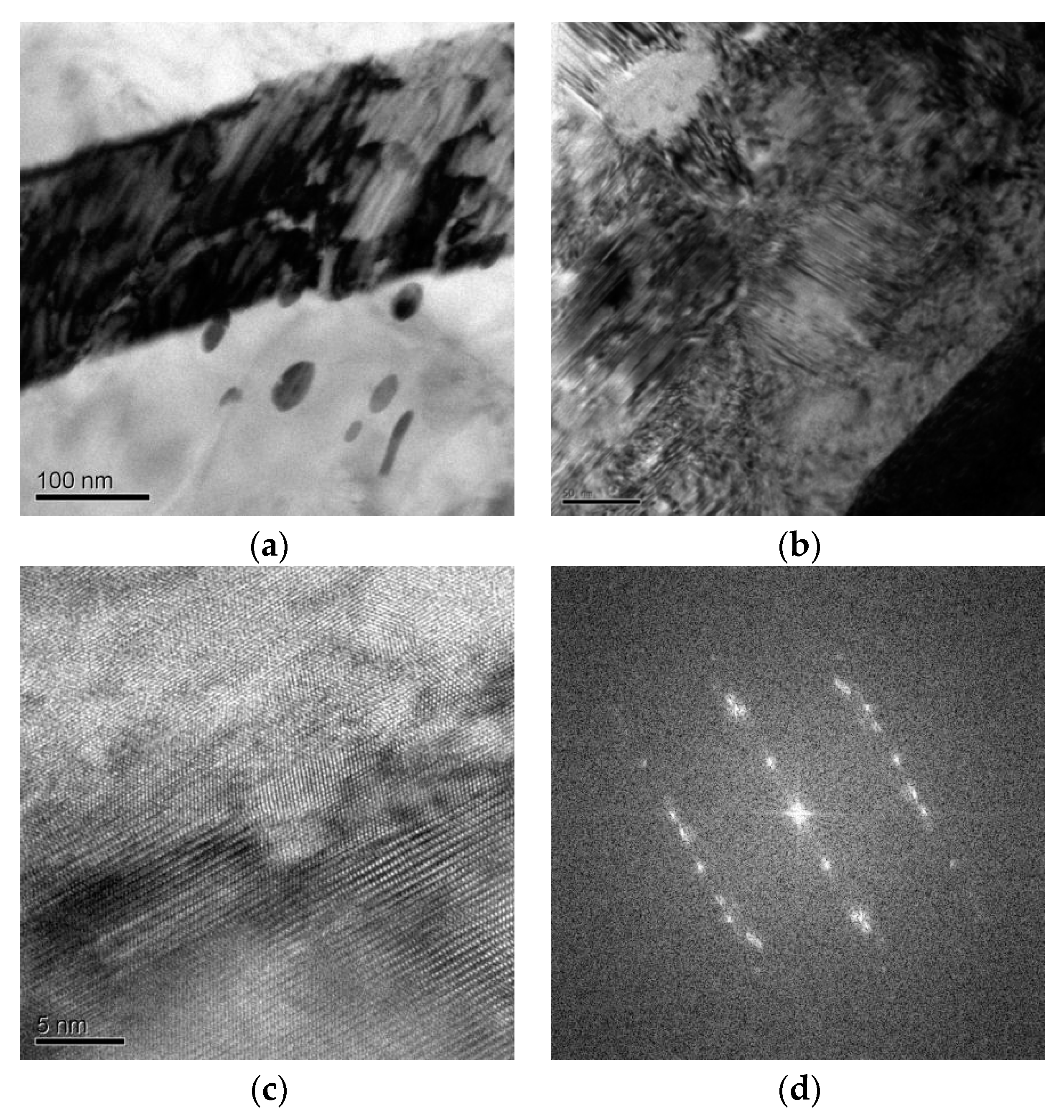
| Alloys | Elements | |||||
|---|---|---|---|---|---|---|
| Ti-10V-2Fe-3Al | V | Al | Fe | O | N | C |
| 9.8 | 3 | 1.9 | 0.11 | 0.01 | 0.07 | |
| Ti-10V-2Cr-3Al | V | Al | Cr | O | N | C |
| 10.6 | 3.19 | 2.18 | 0.1 | 0.013 | 0.05 | |
| Ti-10V-1Fe-3Al | V | Al | Fe | O | N | C |
| 9.97 | 3.02 | 0.97 | 0.11 | 0.014 | 0.051 | |
| Alloys | Ti-10V-1Fe-3Al | Ti-10V-2Fe-3Al | Ti-10V-2Cr-3Al | |
|---|---|---|---|---|
| Temperatures | ||||
| 700 °C | 1218 | 1068 | 1085 | |
| 800 °C | 810 | 1037 | 1366 | |
| 900 °C | 1096 | 1100 | 1366 | |
| 1000 °C | 1229 | 1364 | 1475 | |
| Alloys | Ti-10V-1Fe-3Al | Ti-10V-2Fe-3Al | Ti-10V-2Cr-3Al | |
|---|---|---|---|---|
| Temperatures | ||||
| 700 °C | 599 | 634 | 700 | |
| 800 °C | 574 | 518 | 522 | |
| 900 °C | 771 | 684 | 609 | |
| 1000 °C | 974 | 784 | 634 | |
| Alloys | Ti-10V-1Fe-3Al | Ti-10V-2Fe-3Al | Ti-10V-2Cr-3Al | |
|---|---|---|---|---|
| Temperatures | ||||
| 700 °C | 2300 | 1920 | 1280 | |
| 800 °C | 3960 | 3960 | 3920 | |
| 900 °C | 3360 | 3400 | 3240 | |
| 1000 °C | 2960 | 3600 | 3480 | |
| Alloys | Ti-10V-1Fe-3Al | Ti-10V-2Fe-3Al | Ti-10V-2Cr-3Al | |
|---|---|---|---|---|
| Temperatures | ||||
| 700 °C | 8044 | 7852 | 8584 | |
| 800 °C | 9968 | 10,500 | 9272 | |
| 900 °C | 9504 | 9245 | 10,036 | |
| 1000 °C | 9544 | 8215 | 9016 | |
| Alloys | Ti-10V-1Fe-3Al | Ti-10V-2Fe-3Al | Ti-10V-2Cr-3Al | |
|---|---|---|---|---|
| Temperatures | ||||
| 700 °C | 1537 | 1520 | 1550 | |
| 800 °C | 1562 | 1869 | 1871 | |
| 900 °C | 1742 | 1858 | 1879 | |
| 1000 °C | 1814 | 1902 | 1905 | |
| Alloys | Ti-10V-1Fe-3Al | Ti-10V-2Fe-3Al | Ti-10V-2Cr-3Al | |
|---|---|---|---|---|
| Temperatures | ||||
| 700 °C | 1021 | 1062 | 1060 | |
| 800 °C | 1019 | 1030 | 1050 | |
| 900 °C | 1214 | 1220 | 1137 | |
| 1000 °C | 1184 | 1190 | 1094 | |
Publisher’s Note: MDPI stays neutral with regard to jurisdictional claims in published maps and institutional affiliations. |
© 2022 by the authors. Licensee MDPI, Basel, Switzerland. This article is an open access article distributed under the terms and conditions of the Creative Commons Attribution (CC BY) license (https://creativecommons.org/licenses/by/4.0/).
Share and Cite
Wen, Y.; Wang, J.; Duan, S.; Li, C. Effect of Solution Temperature on Tension-Compression Asymmetry in Metastable β-Titanium Alloys. Metals 2022, 12, 1352. https://doi.org/10.3390/met12081352
Wen Y, Wang J, Duan S, Li C. Effect of Solution Temperature on Tension-Compression Asymmetry in Metastable β-Titanium Alloys. Metals. 2022; 12(8):1352. https://doi.org/10.3390/met12081352
Chicago/Turabian StyleWen, Yong, Jun Wang, Shiyun Duan, and Cong Li. 2022. "Effect of Solution Temperature on Tension-Compression Asymmetry in Metastable β-Titanium Alloys" Metals 12, no. 8: 1352. https://doi.org/10.3390/met12081352





